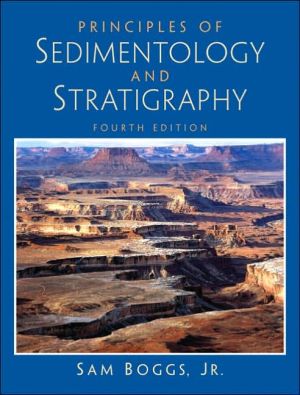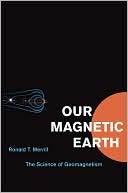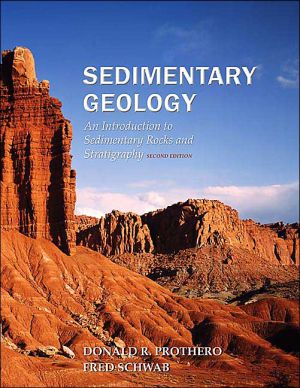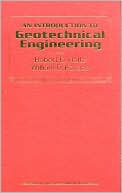Principles of Sedimentology and Stratigraphy
Principles of Sedimentology and Stratigraphy is a thoroughly modern, textbook that provides in-depth coverage of all major aspects of sedimentology and stratigraphy. Aimed at advanced undergraduates but suitable also for graduate students and professionals, it covers processes of sedimentation, describes the characteristics of sedimentary rocks formed in major sedimentary environments, and discusses the fundamental principles of stratigraphy and basin analysis, including recent developments...
Search in google:
This concise treatment of the fundamental principles of sedimentology and stratigraphy highlights the important physical, chemical, biological, and stratigraphic characteristics of sedimentary rocks. It emphasizes the ways in which the study of sedimentary rocks is used to interpret depositional environments, changes in ancient sea level, and other intriguing aspects of Earth’s history. Booknews Primarily for advanced undergraduates, but also suitable for graduate students, this revised and updated textbook (first edition was 1987) provides a comprehensive, in-depth treatment of the processes that form sedimentary rocks. It describes the important physical, chemical, biological, and stratigraphic characteristics of these rocks, and explores the various ways in which study of sedimentary rocks is used to interpret depositional environments, changes in ancient sea levels, and other aspects of Earth history. It also discusses recent developments in the fields of magnetostratigraphy, seismic stratigraphy, sequence stratigraphy, and isotope stratigraphy. Annotation c. Book News, Inc., Portland, OR (booknews.com)
PREFACE: \ Preface\ The study of sedimentary rocks extends back in time to at least the 16th century, thus, placing sedimentology and stratigraphy among the oldest geologic disciplines. Nonetheless, they remain exciting fields of study today. New discoveries and innovative ideas continue to emerge as sedimentologists and stratigraphers, aided by advanced, modern tools, focus research efforts on new areas of study such as global climate change and isotope stratigraphy. Perhaps the most important new geologic concept to arise in the past half-century, for all disciplines of geology, was the concept of seafloor spreading and plate tectonics. This concept, which emerged in the early 1960s, hypothesized that Earth's outer shell is broken into a number of "plates," which are being driven apart along spreading ridges and shoved together along trenches. This elegantly simple idea paved the way for modern thinking about geologic processes and geologic history. Emergence of the seafloor-spreading model spurred research in many fields of geology, resulting in the generation of several other important sedimentological and stratigraphic concepts in the latter half of the 20th century.\ Formulation of the concept of seafloor spreading was quickly followed by major developments in the fields of magnetostratigraphy (study of geomagnetic polarity reversals in volcanic and sedimentary rocks), seismic stratigraphy (study of seismic data for the purpose of extracting stratigraphic information), sequence stratigraphy, (application of the concepts of depositional sequences), and chemostratigraphy or isotope stratigraphy. Sedimentology and stratigraphy have thus largely shed theirprevious image as descriptive disciplines focused on rock descriptions and stratigraphic terminology. This book explores these new developments, and presents an integrated picture of the interrelationship of sedimentology and stratigraphy.\ Although major developments of the stature of seafloor spreading have not taken place since the publication of the second edition of Principles of Sedimentology and Stratigraphy, new ideas have come along and fresh data have become available. A great deal of recent research focuses on factors such as global climate change, depositional environments, and sea-level changes. As career opportunities for geologists move away from the more traditional avenues of energy and mining toward environmental issues and applications to problems that affect society, it is important for students to keep abreast of new developments, as described in this third edition.\ The third edition of Principles of Sedimentology and Stratigraphy retains the basic structure of the previous editions; however, it has been thoroughly updated and new sections have been added covering areas such as paleoclimates, depositional environments, and sequence stratigraphy. Extensive changes have also been made in the artwork. Approximately half of the line drawings and photographs that appear in the third edition are new. The book is aimed primarily at advanced undergraduate and graduate students; however, professionals may also find the book useful to update their knowledge of recent developments in the field. Although thorough and rigorous, the book requires only modest preparation in geology, chemistry, physics, and mathematics.\ About the Author\ In the early stages of his professional career, Sam Boggs, Jr., worked as a petroleum exploration geologist for Phillips Petroleum Company, searching for new oil fields in the Four-Corners region of the Rocky Mountains, prior to receiving his Ph.D. Degree from the University of Colorado. He then worked for a time as a research geologist for Exxon Production Research Company before beginning an academic career. After joining the University of Oregon in 1965, he taught and carried out research in sedimentary petrology, stratigraphy, field geology, petroleum geology, and geological oceanography: During sabbatical leaves from the Universtiy, he served as a Scientist-in-Residence at the Argonne National Laboratory, University of Chicago, visiting professor at the Ocean Research Institute, University of Tokyo, and visiting professor at National Taiwan University's Institute of Oceanography. He was also employed part-time as a research geologist with the U.S. Geological Survey over a fifteen-year period. During his career, Dr. Boggs authored numerous scientific papers in sedimentary petrology, geological oceanography, stratigraphy, and low-temperature geochemistry. He is also author of four previous books. He currently lives in Eugene, Oregon, where he continues to do research as a Professor Emeritus at the Universtiy of Oregon.
1Weathering and soils32Transport and deposition of siliciclastic sediment213Sedimentary textures514Sedimentary structures745Siliciclastic sedimentary rocks1196Carbonate sedimentary rocks1597Other chemical/biochemical and carbonaceous sedimentary rocks1978Continental (terrestrial) environments2459Marginal-marine environments28910Siliciclastic marine environments33411Carbonate and evaporite environments36612Lithostratigraphy39913Seismic, sequence, and magnetic stratigraphy43314Biostratigraphy47815Chronostratigraphy and geologic time51316Basin analysis, tectonics, and sedimentation550App. AForm and roundness of sedimentary particles582App. BPaleothermometry585App. CNorth American stratigraphic code588App. DNomenclature of global and North American chronostratigraphic units615App. EWeb sites pertaining to sedimentology and stratigraphy619
\ BooknewsPrimarily for advanced undergraduates, but also suitable for graduate students, this revised and updated textbook (first edition was 1987) provides a comprehensive, in-depth treatment of the processes that form sedimentary rocks. It describes the important physical, chemical, biological, and stratigraphic characteristics of these rocks, and explores the various ways in which study of sedimentary rocks is used to interpret depositional environments, changes in ancient sea levels, and other aspects of Earth history. It also discusses recent developments in the fields of magnetostratigraphy, seismic stratigraphy, sequence stratigraphy, and isotope stratigraphy. Annotation c. Book News, Inc., Portland, OR (booknews.com)\ \







